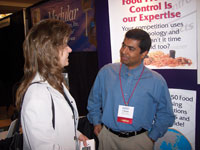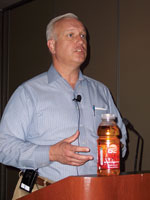

Specialists from more than 50 service and technology firms were on hand to discuss their solutions for food and beverage production at the Expo.
Total throughput, overall equipment effectiveness (OEE) and other metrics are widely applied to gauge manufacturing performance in food and beverage. Those measurements may be inadequate, however, particularly as customer demands and production requirements change. Asset utilization is the new mantra at some of the industry’s leading firms, and a panel of engineering experts shared their thoughts and observations on this kind of measurement with the 170 engineers, plant managers and other food professionals at this year’s conference.
Line speed, up time, yield and other traditional performance measures sufficed when whole birds and cut-up fryers constituted finished goods at poultry plants, observed Allen Merritt, former vice president of science and technology at Gold Kist, which was acquired in 2007 by Pilgrim’s Pride Corp. As further processing became a larger part of the firm’s business, “we realized we needed to know if we were making the right product, in customer specs, or just lots of it.”
Conventional measures of line utilization work against new products and even line extensions that are essential to a manufacturer’s long-term health, added Richard Schumacher, director of process engineering at ConAgra Inc. “If you don’t have volume, line utilization is going to go down,” he noted, and unless utilization goals are flexible enough to accommodate the ramp up of future hit products, production and R&D personnel will be at odds. To avoid counter-productive struggles, “reach out to those crazy folks in R&D when designing your front end,” he advised. Collaboration helped nurture a ConAgra frozen meal that is expanding capacity and emerging as a sales star.
Purchasing new, heavy-duty equipment instead of refurbished machines usually yields a higher return on capital or net assets, panelists agreed, given the reduced maintenance costs and unscheduled downtimes. Return on human assets is more difficult to convey to financial managers, though intuitively, production managers know optimizing human talent has the highest potential return on investment. Campbell Soup has tried to measure the degree of workforce engagement for seven years, related Dave Watson, vice president-engineering at Campbell’s Pepperidge Farm division. “Retaining top talent is a key driver,” he added, and his organization is concerned about a looming “brain drain” as older engineers retire or leave. The company is actively recruiting young engineers and transferring legacy knowledge to them before it is too late.

A tent on the beach provides a relaxed setting for attendees at the conference’s barbeque dinner.
In-house training is a faster way to reach many people, and PMMI worked with a former Kraft and Nabisco official to develop a two-day training and documentation program to help companies build their internal training capacity. Videos, on-line learning and other alternative media are effective, “but we often find the most effective tool is to post how-to pictures right where the person performs the job,” Ferrante said. A picture can equal a thousand words of how-to text, making a digital camera “one of the best tools for training.”

Anheuser-Busch’s Angie Slaughter discusses advanced predictive controls with Chetan Chothani, principal of Adaptive Resource.
“Anytime you can involve operators in statistical process control is going to improve the outcome,” Leins counseled. Operator involvement gradually was ratcheted up at his Toluca, IL plant, to the point that a team joined managers in a nationwide tour of machine builders to evaluate case-packers. “How operators rated the machines was given the same weight as the engineers’ input,” he said. “When the machine finally was installed, they wanted it to run as well as possible.”
Staff involvement also is critical if sustainability efforts are to transition from public relations programs to smart-business strategies. Suppliers, clients and consumers all are idea sources and communication targets in those efforts, but central to a sustainability program’s success is staff involvement.

Gatorade’s Arnie Wodtke discusses his company’s efforts to introduce more sustainable packaging and manufacturing practices.
Sustainability as competitive advantage
Best practices in building design are being influenced by business and social trends. Conferees benefited from two food professionals with particular insight in sustainable building design: Arnie Wodtke, director-hot fill supply chain at Gatorade’s Wytheville, VA facility, the first beverage plant to receive US Green Building Council’s Gold LEED certification, and Jim Green, ambassador at Kettle Foods, which built the second Gold-certified food plant in Beloit, WI. They were joined in a special environmental sustainability forum by Donald Wilkes, president and CEO of Blue Pacific Flavors Inc., Irwindale, CA.Achieving LEED Gold added $2.6 million to Gatorade’s cost, less than 2% of the total investment, Wodtke estimated. Quantifying both the hard and soft returns is difficult, though corporate parent Pepsico believes they are both substantial and critical to the organization’s long-term viability. Lost-time injuries are down 80%, energy consumption has been reduced 21% despite 10% greater throughput, and 100 fewer trucks a day shuttle in and out. “Sustainability will be a competitive advantage in the future,” he said. Waterless bottle rinsing and a nanofiltration system reduce consumption by 92 million gallons a year, an efficiency gain that is gaining public policy importance. “The battlefield over water is there,” Wodtke noted. “The beverage industry has to step up to the fact that we have to manage our resources.”
In-house engineers drove many of the efficiency improvements, particularly in the packaging area, but outside experts and sustainability leaders, particularly from California, were tapped for others. An anaerobic digester and methane-capture system tie Gatorade to Anheuser-Busch Companies Inc., the world leader in the technology. Conference keynoter Jeff Steinhart referenced the technology link, noting the brewer’s “bio-energy recovery system” contributes 18% of the gas needed to power boilers at A-B’s Jacksonville, FL brewery. Besides contributing engineering counsel, A-B provides bacteria to Gatorade when it’s necessary to recharge the Wytheville plant’s system. “We take them off the beer, put them on the Gatorade, and in two weeks they’re fit and trim,” Wodtke joked.
As a natural foods firm, Kettle Foods’ embrace of sustainability came naturally, Green noted, though “some of it is flat-out good business.” People who buy Kettle’s premium potato chips expect the company to invest in renewable energy and engage in environmentally sound practices. In a sense, the company’s sustainability spending can be classified under customer retention. In 2003, a solar power system with 616 panels was installed at the company’s Salem, OR facility. Grants, tax credits and other subsidies dropped the final cost of the $650,000 energy system to $60,000, though it still took six years to get a return. A similarly long payback can be expected from the 18 wind turbines installed at the Beloit plant: At current rates, the annual value of the electricity generated is about $2,000. But sustainability and partnering with like-minded organizations is fundamental to Kettle, and the firm continues to explore other initiatives. “Packaging is our Achilles heel,” he concluded. “Plastic is never going to go away. What can we do to mitigate it?”
Wilkes’s company tackled packaging waste head-on as part of an overall sustainability focus. “Packaging accounts for half of the municipal waste stream,” he pointed out, and Blue Pacific’s ideals were to re-use and recycle materials, eliminate unnecessary packaging and employ low-impact, natural materials. New packages had to be at least as functional, more efficient and communicate a quality image. Those goals were met, and the 60% reduction in packaging materials helped pay for the effort. Wilkes advised others to partner with innovative material suppliers, start out with a single package and learn from the project before making wholesale changes. He also emphasized the need for staff involvement: “The passion from our employees had to be there at the outset.” One initiative to kindle sustainability passion is a corporate subsidy on the down payment for hybrid vehicles purchased by Blue Pacific workers.

Happy hour lends a relaxed feel to the conference’s Expo, which also featured a full line-up of Solutions Theaters, where exhibitors presented detailed information on manufacturing technology.
Raising the cleanability bar
Best practices in sanitary design are tempered by cost considerations, observed Dwight Nickerson, an Indianapolis-based process engineer with CH2M Hill, with plant professionals forced to relegate some features into the “not required” category and choose between multiple options for “required” features. “The option we want the most costs the most,” allowed Nickerson, making the economic evaluation the most challenging aspect of plant and equipment design.It helps to own the business when biting the design bullet. That was the case at Beef Products Inc., the Dakota Dunes, SD-based fabricator of boneless, lean ground beef from trimmings. “You have to believe in it [sanitary design],” emphasized Eldon Roth, BPI’s founder and president. “We have spent a lot of dollars on it. The short-term cost is horrendous,” but the long-term payback is “very reasonable.”
Larval and adult insects infest the concrete walls of food plants, Roth discovered years ago, motivating him to specify 3/8-in. stainless steel plates for the ceilings and walls of his newest facility. Even stainless-steel floors have been tried, though effective slip-resistant aids have been a problem. Expansion beads between the panels result in enclosed rooms that can be CIP’d.
More affordable sanitation practices at BPI include raising freezer units off the floor, rather than live with the inevitable bacteria colonization that occurs when units rest on the floor. Refrigeration coils are “some of the most effective bacteria spreaders in the world,” noted Roth. “We wash ours almost constantly and automatically with a CIP system.” Drives and motors are coated with a polymer to promote hygiene, though thermal transfer suffers. And a high-pressure system that forces a short blast of water at a rate of 1,500 gallons a minute from the CIP system into the plant’s drains effectively evacuates any proteins and reduces the amount of chemical solvents needed for cleaning.
BPI has made effective use of ammonium hydroxide as an antimicrobial compound. A recent application involves a 250 psi spray delivered to beef, poultry and other meats. In a study by Iowa State University, a 3.4 log reduction in Listeria cultures was achieved, while other interventions achieved load reductions of 1 log or less, according to Roth.
Growth through acquisition helped J&J Snack Foods achieve 36 years of consistent growth, and President and CEO Gerald Shreiber described the success he has enjoyed since 1971 in trolling bankruptcy court liquidations and buying other financially stressed companies. But J&J’s 145 straight profitable quarters are attributable to three practices, he explained: Strive to be the low-cost producer, deliver a quality product to a niche market, and dominate the marketing and logistics in a given category.
Best practices in automation standards, employee safety and data reporting were among the other areas explored in presentations and face-to-face conversations. Attendees didn’t leave Florida with all the answers, but at least they now have a clear idea of the key questions and how their peers address them.

Florida sunshine and an outdoor buffet provide an opportunity to trade notes and unwind after a full day of thought-provoking discussions.
Eye on China
Jeff Steinhart, vice president-engineering at Anheuser-Busch Inc., highlighted the St. Louis-based brewery’s efforts to cultivate 1.3 billion new Bud men and women in his keynote address on manufacturing innovation at this year’s Food Automation & Manufacturing Conference. But manufacturers who think China is production’s new Wild West should think again: The same social responsibilities and environmental stewardship the public demands from US firms apply in the Far East, he emphasized, and any domestic food companies contemplating entering the Chinese market will be in peril if they ignore that reality.Energy costs trail the US and Europe only slightly, he said, and the same boiler-stack emission controls and waste treatment requirements apply. Water availability looms as a huge issue, and “their knowledge of how much they have below the ground is sketchy,” Steinhart said. “The last thing we want is to build a greenfield [plant] and only have water for three years.” The company is investing in research to determine groundwater supplies in both China and India.
The beer company already operates three breweries in China, and its first new facility is slated to open in the fall. With an annual capacity of about 2.5 million barrels, the facility is small by US standards, though larger projects are difficult to capitalize, given the going rate of 36 cents for a six-pack in China. When A-B builds its next China brewery, it will be able to source all materials domestically, including equipment that meets international standards. “Some local suppliers have been acquired, and that has helped,” Steinhart says. “There’s been a lot of German influence in packaging equipment and piping.”
The days when companies set up Chinese plants to tap cheap labor and avoid environmental and safety rules are drawing to a close. Engineers participating in the conference’s Ask the Experts panel offered differing perspectives on the Chinese market, but there was consensus on rising labor costs and stiffer regulatory requirements. “We need to be true to our quality standards and force the rest of the world to come up to them,” emphasized Richard Schumacher, ConAgra Inc.’s director-process engineering.
